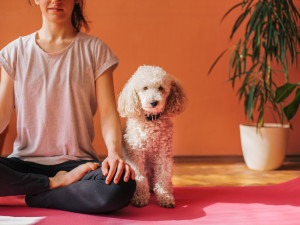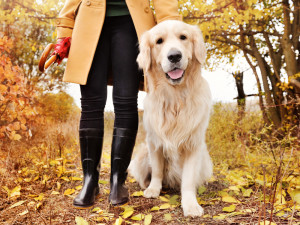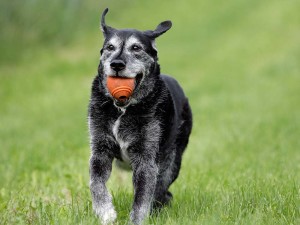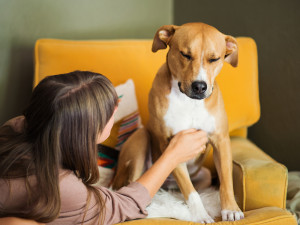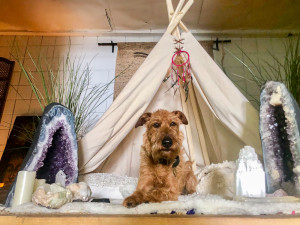Does Your Dog Need a Massage?
Help your dog stay fit and flexible with these stretch techniques by a certified pet strength and conditioning specialist.

Share Article
Gentle massage and stretching promote improved joint health in dogs. Follow these guidelines for safe techniques that increase mobility and flexibility:
Step One: Take It Slow.
Start slow, initially keeping sessions brief while watching closely for reactions indicating discomfort. Stop immediately if your dog yelps, growls, nips, or flees. Never force a position or push past visible resistance from them.
Step Two: Use Positive Reinforcements.
Reward your dog with treats, praise, or pets when they voluntarily relax into stretches to teach them extending is safe and pleasant. Partner stretches can deepen the impact while providing quality bonding time together.

Step Three: Use Proper Massage Technique.
Apply gentle circular massage using thumbs and palms to major joints and tight muscles prone to stiffness like hips, lower back, knees, ankles, shoulders, and neck. Research proper hand placement and pressure levels beforehand to avoid harm.
Step Four: Adjust Pressure Based on the Area.
Respect sensitive areas like paw pads, old injuries, or surgical sites. Instead, focus on areas where your dog enjoys the massage and traction movements.
Step Five: Take Other Steps to Promote Mobility.
Invest in orthopedic dog beds, traction socks, balance discs, and other supportive items, allowing passive flexibility gains without manipulating their body. These maintain comfort while working areas prone to inflexibility.
Step Six: Monitor Your Pet’s Reaction.
Pay attention to any indicators of discomfort like flinching, shifting away, or halting active movements. This helps determine optimal pressure levels and frequencies tailored to their needs. Adapt touch and stretches based on their unique pain signals.
Benefits of Stretching Your Dog
Keeps muscles supple and flexible
Boosts circulation
Increases oxygenation and hydration
Enhances dog/person bond
Engenders feelings of calm and contentment
Movement is how a dog’s body heals. Dogs can maintain and even improve mobility and range of motion of the joints with just a few minutes of stretching and massage each day. “The act of stretching fires off nerve endings in the muscles, preparing them for the activity. Stretching also helps warm up the dog’s muscles, possibly averting damage from the exercise,” says Dr. Michael Petty, DVM. When it comes to health, mobility, and pain management, consistency — rather than intensity — is key.
Types of Dog Massages and Stretches
Similar to Yoga, the following dog stretches are home exercises that are safe and rewarding for you and your dog. Once you have the green light from your vet, incorporate the following dog stretches and massages into your dog’s regular rubbing routine.
Butt & Back Rub
Keep your pup’s back in tip-top shape — and nerve impingement to a minimum — with some light massage on the sacrum, located above the base of the tail between the hip bones. Use light pressure and circular movements over this hard flat surface. Proceed up the length of your dog’s spine with gentle massage strokes. (When in direct contact with spinal vertebrae, use very little pressure.)
Results: Increased spinal fluid flow, root chakra balance, decreased anxiety, mobility of the hips and spine, freedom of movement.
Back Leg Stretch
Decreased mobility of the hips and deterioration of the knee are major problems for elderly canines. Keep your dog perky by loosening up their hip, lower back, and leg muscles. Take hold of their rear leg near the knee and gently pull the leg back in an extended position. Move slowly and confidently. Hold the stretch for a few seconds, release and repeat.
Results: Increased mobility of the hips and flexibility in the spine; decreased pain associated with arthritis; improved health of the low back, hip and leg muscles; oxygenation of the ankle, knee and hip.
Shoulder Stretch
More than 60 percent of your dog’s body weight is absorbed by their shoulders. Improved range of motion at the shoulder equals greater mobility, less pain, and looser chest, shoulder, and upper back muscles. Move your dog’s front leg forward in an extended position. (Stabilize movement at the elbow for a more intense stretch.) Hold this stretch for a few seconds, release, and repeat. Once you have completed this shoulder stretch, move the dog’s leg forward and back in a pendulum movement to further release the muscles of the shoulder, chest and back.
Results: Integrity of the shoulder girdle; increased breathing capacity; improved health of the wrist, elbow and shoulder; decreased pain; freedom of movement.
Chest Opener
Your dog’s chest musculature endures a tremendous amount of strain. Offer some relief with this abduction (away from center) stretch. Take hold of their front legs near the wrists and gently open them out to the side. Hold for a few seconds, release and repeat. Finish up with a gentle chest massage.
Results: Softening of the brachial and cardiac plexus, ensuring a calm canine; heart chakra balance; hydration of the chest, shoulder and intercostal (between the ribs) muscles; increased breathing capacity.
Belly Rub
Your dog’s soft belly is a sensitive area, so be especially gentle when touching this spot. Gently place your hand on their belly, wait for a pulse or heat, then release and repeat. Move hands in a clockwise circular motion to treat constipation; use a counterclockwise motion to treat diarrhea.
Results: Decreased anxiety; loosening of the muscles along the front of the spine; increased mobility of hips, low back and spine; softening of the solar plexus and diaphragm; increased breathing capacity.
* All moves can be performed while your dog is either standing or lying down.
Cookie Stretching Exercises
Dr. Michael Petty offers some useful advice for additional stretching tips in his book, Dr. Petty’s Pain Relief for Dogs: Cookie stretches are used to help increase flexibility and range of motion. Cookie dog stretches do not put undue stress on any part of the body because the dog themselves (with the aid of a cookie under their nose for encouragement) decides on the degree of stretch. Use any food that your dog finds irresistible. A small piece of cheese, bit of lunchmeat or chunk of hot dog will work great. Just remember, it is not the size of the treat, but the smell of it hidden in your hand that will make your dog stretch.
Take a treat and lure your dog’s snout to each of the following areas.
Hip (their hip / lower back area)
Hock (mid-thigh)
Shoulder (shoulder area)
Elbow (each front elbow)
No matter where an injury is in his body, your dog will compensate by twisting, leaning, weight shifting and so forth so that even the “good” limbs start to experience excessive wear and tear. This means that all areas, not just the problem areas, can benefit from stretching exercises, so do a cookie stretch to each area.
Guidelines for Keeping Dog Stretches Safe
As a reminder to keep stretches both safe and positive, Dr. Petty adds a few guidelines to keep in mind:
Prior to starting any increase in physical activity, it is important to make sure that your dog does not have any medical condition that might make it dangerous to do so. Have a discussion with your veterinarian before starting your dog on any exercise program.
Always show your veterinarian the specific exercises you have in mind for your dog, whether you got them from here or elsewhere, to make sure they are not contraindicated by any existing medical condition. If it seems like it hurts, stop.
Follow the schedule recommended by your veterinarian because they know your dog best. They might know of some medical issues that could impact the safety of the exercise for your dog.
Don’t forget, you are trying to rehabilitate your painful dog, not put her through boot camp. Make it fun and reward your dog with praise and the occasional treat. You want them to finish with the memory of this as being a fun thing.
Dog Massage Tips
Be gentle, patient and attentive.
Set your intention on healing.
Watch for signs of discomfort and adjust your approach accordingly.
Provide a safe, quiet environment when using “hands-on” modalities.
Take note of bumps, areas of heat and sensitivity, and changes in the skin and fur.
Discuss all abnormal findings with your vet.
Follow your dog’s lead.

Raquel Wynn, CSCS, CPT, LMT
Raquel Wynn, CSCS, CPT, LMT, based in Nashville, TN, is the author of the book Stretch Your Dog Healthy and the host of petliferadio.com’s “Wynn with Dogs.”
Related articles
![Happy golden retriever dog on a walk with owner in woodsy yellow and orange fall setting with leaves on the dirt trail.]()
Home Remedies for Dog Joint Pain Relief
DIY ways to help your pup cope with the pain.
![Older dog playing with ball in a green field]()
Dog Arthritis Treatment: How to Relieve Arthritis Pain in Dogs
Tips for treating achy joints — from medications to massages.
![A pet parent checks their dog's stomach.]()
DIY Physical Exam Part 4—How to Examine Your Dog’s Stomach and Skeleton
Veterinarian Dr. Shea Cox on how to properly examine your dog’s stomach and musculoskeletal system.
![Dog sitting in a tent surrounded by candles and crystals]()
Alternative Therapies Can Zen Out Your Pet, Too
Wellness treatments like acupuncture, Reiki, and sound baths are helping pets heal and bond with their parents.
